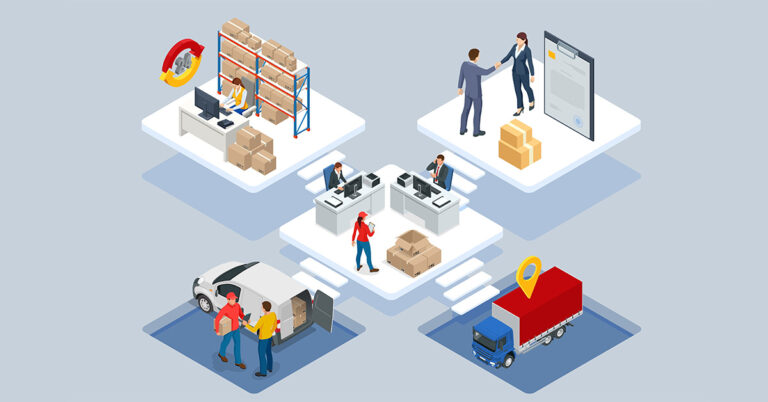Why you should optimise your freight management process
Businesses of all sizes are grappling with supply and demand fluctuations, energy price increases, inflation, global trade disruptions, and environmental pressures. In this landscape, effective freight management can help companies unlock operational efficiency and significant cost savings.
Increased efficiency.
Streamlining logistics operations, optimising transportation and warehousing processes can boost your business productivity.Improved visibility.
Starting with a comprehensive analysis of your logistics operations allows you to gain a holistic view and adopt a ‘continuous improvement’ approach to freight management, yielding both immediate and long-term results.Reduced costs.
By identifying fuel-efficient routes, optimising modes of transportation, and eliminating manual processes, companies can make substantial savings.Shorter delivery timelines.
Optimising routes, schedules, and load capacities improves delivery times and reliability which directly impact customer satisfaction.

See how The Blue Space streamlined their operations with MachShip.
How to streamline your freight operations
Struggling to control freight costs and admin hours as your business grows? Here are our top freight management process tips.
Assess Current Operations
Before making changes, it helps to know where you’re at. This allows you to establish benchmarks, so you can measure progress and see what’s actually moving the dial for your business. Set goals in tangible areas, such as reducing transport costs, improving delivery times, or minimising errors in order processing. You don’t necessarily need to target exact numbers to achieve, but you at least need to know your starting point in order to be able to track ongoing progress.If you don’t have a system in place that allows you to consolidate enough data to get a clear overview of your business operations, then implementing one should be a priority.Enhance Supply Chain Visibility
Today’s technology provides greater visibility over your supply chain which allows you to benchmark your performance, identify areas for improvement, and progressively optimize your processes. There are a few tools that can help you with this.Freight Management Systems (FMS): Learn more
Route Optimisation Software: Learn more
Implement Real-Time Data & Analytics
If you weren’t already aware of your exact problem areas, real-time visibility over your shipping patterns will help you identify peak times and potential bottlenecks. Once you’re clear on your shipping needs, you can better negotiate with carriers and ensure capacity during busy periods.MachShip provides an all-in-one freight management platform. Check out the full list of benefits.Incentivise Carriers & Service Providers
Having an automated freight management system in place allows you to filter carriers by a range of metrics like price and delivery time. You can also block carriers who don’t meet certain criteria – for example, if you require a certain mode of transport that can handle fragile or dangerous goods.By being able to track deliveries, you’ll be able to prioritise the best performers. This naturally incentivises carriers to improve their offering in order to win your business.Optimise Storage & Consolidate Shipments
Organise your warehouse layout strategically to minimise loading time and streamline order fulfilment. Consider factors such as product popularity, storage capacity, and order picking processes to improve operations.Whenever possible, consolidate smaller shipments into one larger shipment. This can reduce handling costs and lead to better freight rates.Prioritise Sustainability
Sustainability is more than a buzzword. It has become a core tenet of business operations. Look for carriers that offer eco-friendly options or consider alternative shipping methods that reduce your company’s carbon footprint.Partner with B Corps and/or look into ways of becoming one yourself
Choose partners with operations powered by solar energy
Use recycled materials in your packaging and shipping materials
Take action to reduce your packaging overall.

Choose the Right Freight Management Software
There are a number of ‘all-in-one’ freight management platforms on the market. However, not all of them are user-friendly. Not all of them can integrate seamlessly with your existing systems. And not all of them are backed by a responsive support team to troubleshoot issues as they arise.With MachShip, you can get unparalleled visibility across your carriers, real-time tracking, and actionable insights from pick-up to fulfilment.
Want to know more about freight management system automation? Book a free demo with our team.
FAQs
- How do you optimise the shipping process?
Optimising the shipping process involves evaluating and refining every aspect of your logistics workflow. This can include choosing the most efficient routes, consolidating shipments, leveraging real-time tracking, automating manual processes, and ensuring that the warehouse layout facilitates quick and error-free order fulfilment.
- How do you optimise freight costs?
Freight cost optimisation can be achieved by:
- Negotiating with carriers for better rates based on volume or long-term partnerships
- Combining smaller shipments into consolidated shipments to take advantage of bulk rates
- Using a route optimisation software to determine the most cost-effective routes
- Regularly auditing freight bills to identify and correct discrepancies
- Implementing a freight management system to automate and streamline operations
- What does optimising transportation and logistics involve
Optimising transportation and logistics refers to the process of making transportation operations more efficient, both in terms of cost and service delivery. This involves the entire logistics chain, from procurement of goods, warehousing, transportation scheduling, route planning, to final delivery.
- What’s a Transportation Management System?.
A Transportation Management System (TMS) is a platform that helps companies plan, execute, and optimise the physical movement of goods, both incoming (inbound) and outgoing (outbound). This includes tools for route planning, carrier selection, freight auditing, and real-time tracking of shipments.
MachShip is a cloud-based freight management platform serving 3PLs, 4PLs, retailers and wholesalers. We’re fully independent, and link you with 200+ Australian transport carriers in just a couple of clicks. Want a free demo? Get in touch here.

